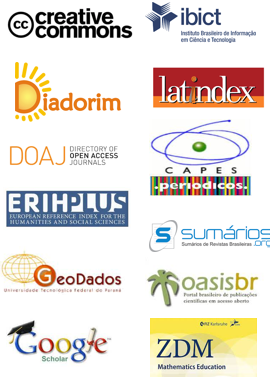Conics Studium 3D: Integration of Computational Resources to Articulate the Semiotic Representation Records of Conic Curves
DOI:
https://doi.org/10.17921/2176-5634.2024v17n2p223-230Resumo
As cônicas têm sido estudadas pelos matemáticos ao longo dos séculos, principalmente através dos diferentes modelos de geometria: sintética (grega), analítica e projetiva. Porém, o estudo das cônicas na educação básica é extremamente limitado seja no Brasil, na França, na Espanha ou no México, e embora ainda esteja presente em diversos cursos universitários, sua abordagem é fragmentada e o foco está nas representações algébricas. Para dar conta das dificuldades encontradas no ensino de curvas cônicas, propomos o projeto de um artefato computacional. Mostramos a necessidade de favorecer uma integração das abordagens sintéticas e analíticas, em oposição à sua fragmentação, uma integração que considere uma articulação entre as diferentes representações, ligando as variáveis visuais às unidades simbólicas correspondentes, através de transformações por conversão e processamento usando um computador recurso. Para atender a esses requisitos, além do estudo matemático e de sua história, empreendemos um estudo cognitivo para especificar a articulação dinâmica de diversas representações de curvas cônicas por meio de recursos computacionais, para que o artefato desenhado possa contribuir para o desenvolvimento global do raciocínio, análise e habilidades de visualização de alunos e professores. Para validação, desenvolvemos o protótipo 3D do Conics Studium, oferecendo a possibilidade de explorar o que chamamos de "registros semióticos dinâmicos", ou seja, articular dinamicamente equações (e suas diferentes formas - transformação por processamento), representação gráfica plana e representação gráfica espacial de cônicas, de modo que fazendo deslocamentos na representação figurativa espacial, obtemos uma modificação do gráfico cartesiano e das expressões algébricas, permitindo um acesso rápido e contínuo a diversas situações (Transformação por conversão).
Palavras-chave: Curvas Cônicas. Representações Semióticas. Registro Semiótico Dinâmico. Software Educacional
Abstract
Conics have been studied by mathematicians over the centuries, especially through the different models of geometry: synthetic (Greek), analytic and projective. However, the study of conics in basic education is extremely limited whether in Brazil, France, Spain or Mexico, and although it is still present in several university courses, their approach is fragmented and the focus is on algebraic representations. In order to cope with the difficulties encountered in teaching conic curves, we propose the design of a computer artifact. We show the need to favor an integration of synthetic and analytic approaches, as opposed to their fragmentation, an integration that considers an articulation between the different representations, linking the visual variables to the corresponding symbolic units, via transformations by conversion and processing using a computer resource. To meet these requirements, beyond the mathematical study and its history, we undertook a cognitive study to specify the dynamic articulation of various conic curves representations by means of computer resources, so that the artifact designed can contribute to the overall development of reasoning, analysis and visualization abilities of students and teachers. For validation, we have developed the 3D prototype of Conics Studium, offering the possibility to explore what we call "dynamic semiotic registers", that is to say to dynamically articulate equations (and their different forms - transformation by processing), flat graphical representation and spatial graphical representation of conics, so that by making displacements in the spatial figurative representation, we obtain a modification of the Cartesian graph and algebraic expressions, allowing a fast and continuous access to several situations (Transformation by conversion).
Keywords: Conic Curves. Semiotic Representations. Dynamic Semiotic Record. Educational Software.


